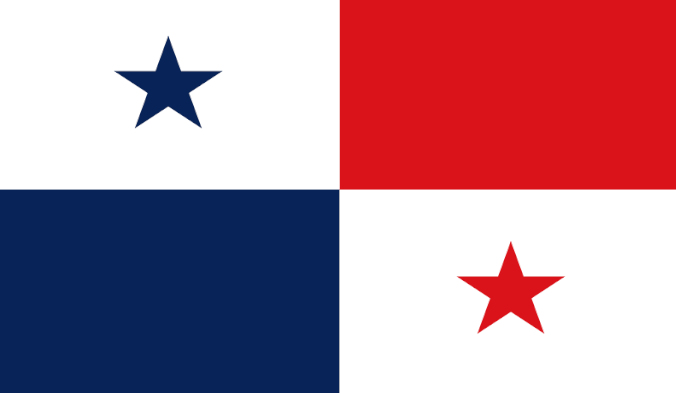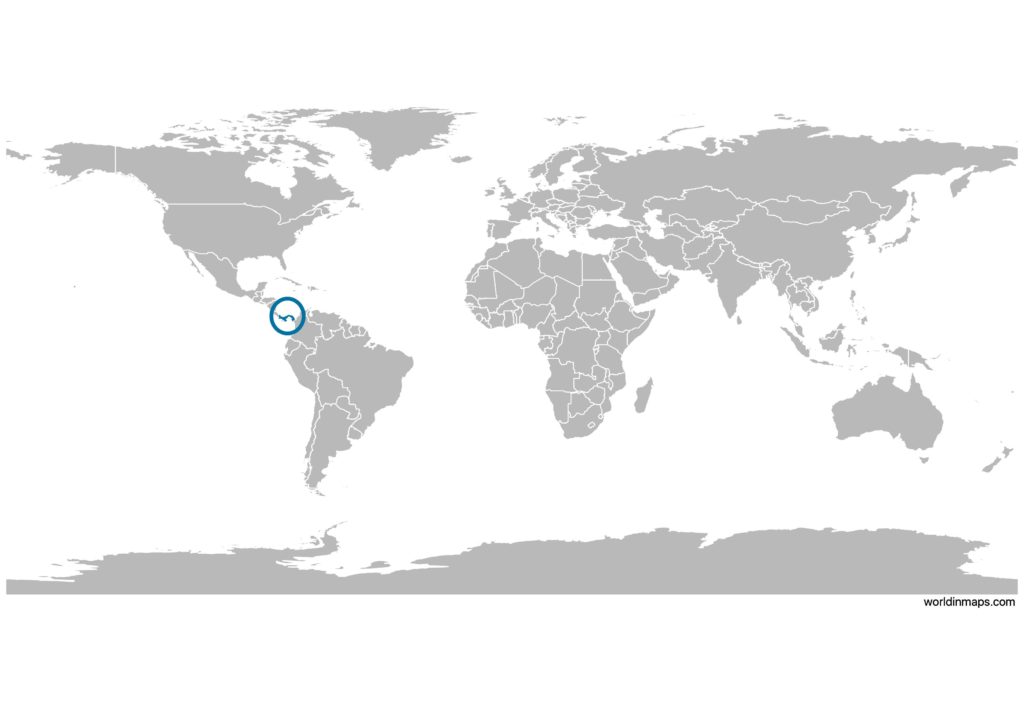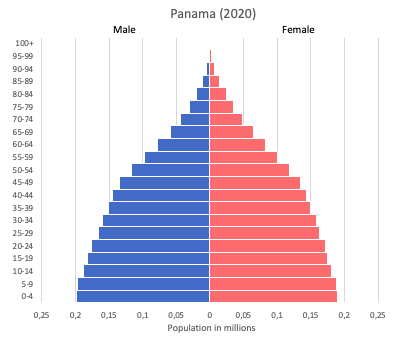Panama

| Government | |
| Name | Republic of Panama |
| Spanish | República de Panamá |
| Government type | presidential republic |
| Capital | Panama City (430,299) |
| Currency | Balboa (PAB) United States dollar (USD) |
| People | |
| Population (2020) | 4,314,768 |
| Density of population | 56 P/km2 (162nd) |
| Nationality | Panamanian |
| Official languages | |
| Spanish | |
| Ethnic groups (2010) | |
| mestizo (mixed Amerindian and white) | 65% |
| Native American | 12.3% |
| Ngabe | 7.6% |
| Kuna | 2.4% |
| Embera | 0.9% |
| Bugle | 0.8% |
| other | 0.4% |
| unspecified | 0.2% |
| black or African descent | 9.2% |
| mulatto | 6.8% |
| white | 6.7% |
| Religions | |
| Roman Catholic | 85% |
| Protestant | 15% |
| Life expectancy (2020) | |
| Male | 76.4 years |
| Female | 82.2 years |
| Total population | 79.2 years (60th) |
| Homicides | |
| Total (2018) | 9.4 per 100,000 people (38th) |
| Geography | |
| Land area | 74,340 km2 |
| water area | 1,080 km2 |
| total area | 75,420 km2 (119th) |
| Mean elevation | 360 m |
| Lowest point | |
| Pacific Ocean | 0 m |
| Highest point | |
| Volcan Baru | 3,475 m |
| Land use (2011) | |
| Agricultural land | 30.5% |
| Arable land | 7.3% |
| Permanent crops | 2.5% |
| Permanent pasture | 20.7% |
| Forest | 43.6% |
| Other | 25.9% |
| Urbanization | |
| Urban population (2020) | 68.4% |
| Rate of urbanization | 2.06% annual rate of change (2015 – 2020) |
| Economy | |
| Labor force (2017) | 1.633 million (129th) |
| Labor force by occupation (2009) | |
| Agriculture | 17% |
| Industry | 18.6% |
| Services | 64.4% |
| Unemployment rate (2017) | 6% (91st) |
| GDP (PPP) (estimate 2020) | |
| Total | $121.749 billion (80th) |
| Per capita | $28,456 (57th) |
| GDP (nominal) (estimate 2020) | |
| Total | $73.369 billion (70th) |
| Per capita | $17,148 (52nd) |
| GDP by sector (estimate 2017) | |
| Agriculture | 2.4% |
| Industry | 15.7% |
| Services | 82% |
| Exports (2017) | $15.5 billion (74th) |
| Exports partners (2017) | |
| US | 18.9% |
| Netherlands | 16.6% |
| China | 6.5% |
| Costa Rica | 5.4% |
| India | 5.1% |
| Vietnam | 5% |
| Imports (2017) | $21.91 billion (72nd) |
| Imports partners (2017) | |
| US | 24.4% |
| China | 9.8% |
| Mexico | 4.9% |
Panama on the world map

Panama top 10 largest cities
- Panama City (430,299)
- San Miguelito (315,019)
- Las Cumbres (127,440)
- La Chorrera (118,521)
- Tocumen (113,174)
- Pacora (103,960)
- Arraiján (96,676)
- David (81,957)
- Vista Alegre (55,114)
- Santiago de Veraguas (51,236)
Demography
Population pyramid

Age structure data
Estimate for 2020:
- 0-14 years: 25.56% (male 508,131/female 487,205)
- 15-24 years: 16.59% (male 329,250/female 316,796)
- 25-54 years: 40.31% (male 794,662/female 774,905)
- 55-64 years: 8.54% (male 165,129/female 167,317)
- 65 years and over: 9.01% (male 160,516/female 190,171)
Remark: the age structure of a population affects a nation’s key socioeconomic issues. Countries with young populations (high percentage under age 15) need to invest more in schools, while countries with older populations (high percentage ages 65 and over) need to invest more in the health sector. The age structure can also be used to help predict potential political issues. For example, the rapid growth of a young adult population unable to find employment can lead to unrest.
Population from 1950 to 2020
Source: United Nations, Department of Economic and Social Affairs, Population Division (2019). World Population Prospects 2019, Online Edition. Rev. 1.
Evolution of the life expectancy from 1960 to 2018
Source: World Development Indicators, The World Bank
Economy
Agriculture:
bananas, rice, corn, coffee, sugarcane, vegetables, livestock, shrimp
Industries:
construction, brewing, cement and other construction materials, sugar milling
Exports – commodities:
fruit and nuts, fish, iron and steel waste, wood
Imports – commodities:
fuels, machinery, vehicles, iron and steel rods, pharmaceuticals
Time zone and current time in Panama
Go to our interactive map to get the current time in Panama